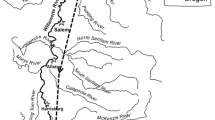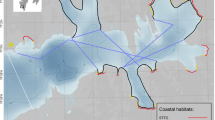Abstract.
The bivalve Macoma balthica migrates twice during the benthic part of its life cycle. During the spring migration (May–June), the newly settled spat (0-group) migrates to the nurseries in the high intertidal. Seven to nine months later, the bivalves migrate back to the low tidal flats and the subtidal (winter migration, 1-group). Both 0- and 1-group M. balthica use byssus threads for active pelagic migrations. As many M. balthica disappear during these migrations, we examined experimentally the importance of predation on 0- and 1-group M. balthica. Laboratory experiments using a circular aquarium determined predation rates on buried (no current) and drifting (current) 0- and 1-group M. balthica by several fish species (plaice, flounder, goby and whiting) and the shore crab. Under illuminated conditions, more M. balthica were consumed when migrating than when buried, whereas there was no difference between experiments in conditions of darkness. For the 0-group, predation rates on migrating and buried M. balthica in the dark were lower than in the light. The stomachs of pelagic fish in the Wadden Sea and Oosterschelde estuary did not contain M. balthica during winter migration. In the Wadden Sea, 1-group M. balthica primarily migrated at night. In conclusion, enhanced predation on drifting, as compared to buried, M. balthica may be the mechanism that explains enhanced mortality during migration in light, and may explain why M. balthica mainly migrates at night in the field. As we found no M. balthica in stomachs of pelagic fish, we do not know whether predation on byssus drifting M. balthica exists in the field. There are, however, some indications for fish predation on infaunal polychaetes during pelagic migrations.
Similar content being viewed by others
Author information
Authors and Affiliations
Additional information
Electronic Publication
Rights and permissions
About this article
Cite this article
Hiddink, .J., Kock, .R. & Wolff, .W. Active pelagic migrations of the bivalve Macoma balthica are dangerous. Marine Biology 140, 1149–1156 (2002). https://doi.org/10.1007/s00227-002-0794-9
Received:
Accepted:
Issue Date:
DOI: https://doi.org/10.1007/s00227-002-0794-9




